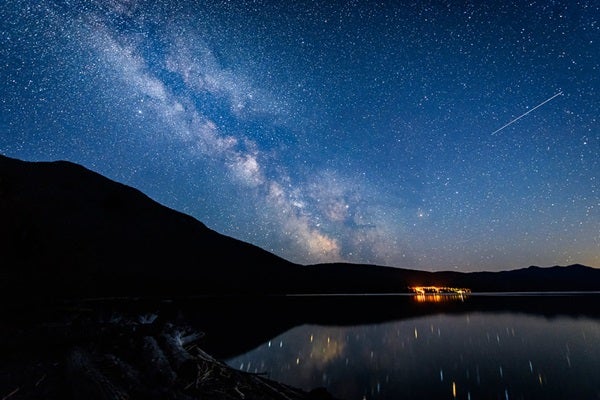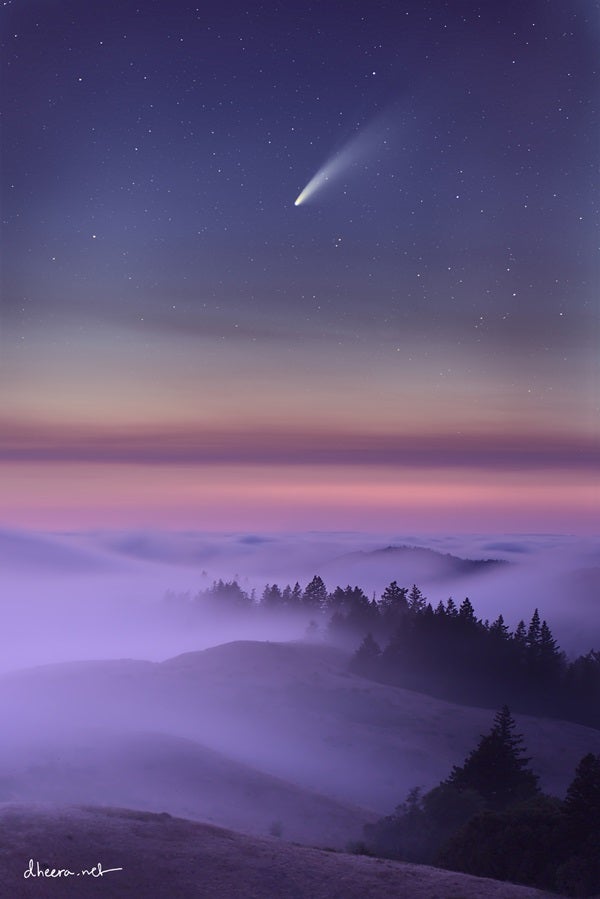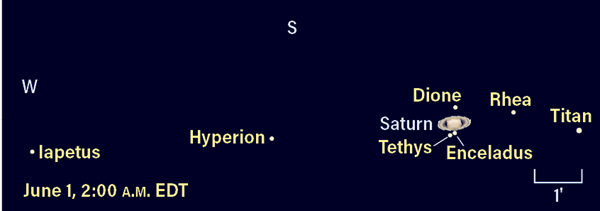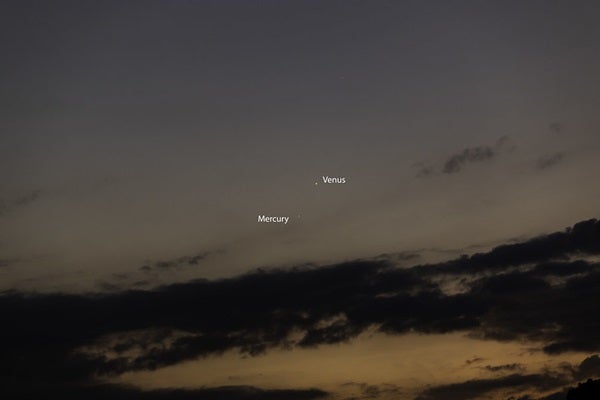Comet C/2020 F3 (NEOWISE) continues to delight as an evening comet. An hour after sunset, it’s roughly 30° high in the northwest. You can find it by drawing a line between the two rightmost stars in the Big Dipper’s cup — Dubhe (at the top) and Merak (bottom) — and continuing the line south another 15° from Merak to spot the comet. Magnitude 3 Al Kaphrah is nearby, about 3° north-northeast of NEOWISE.
Saturday, July 25
The Moon reaches perigee, the closest point in its orbit around Earth, at 1:02 A.M. EDT. At that time, it will stand 228,889 miles (368,361 kilometers) from our planet. Tonight, our satellite is a 34-percent-lit waxing crescent in Virgo. You’ll find it about one-third of the way on a line drawn from magnitude 1 Spica northwest toward magnitude 2.1 Denebola, the tail of Leo the Lion.
Look about 28.5° above the Moon to see another bright star: magnitude –0.1 Arcturus, Boötes’ alpha star. Scan farther northwest to find the familiar Big Dipper asterism, which is part of a much larger constellation: Ursa Major the Great Bear.
Sunday, July 26
Observers willing to brave the wee hours of the morning will be rewarded with a dark, moonless sky today. If it’s particularly clear, consider searching out the Dumbbell Nebula (M27), located in Vulpecula the Fox. This planetary nebula — the result of an aging Sun-like star puffing away its outer layers late in life — was discovered by Charles Messier in 1764. You’ll find it amidst the dusty plane of the Milky Way, which is standing straight up from the southwestern horizon around 2 A.M. EDT. At that time, M27 is roughly 70° high and, although it’s a bit challenging with binoculars, a small scope will easily show it. A larger scope will bring out more detail. Most telescopes should reveal the nebula’s bi-lobed structure, from which it gains its name.
Nearby is open star cluster NGC 6885 (Caldwell 37). This magnitude 6 cluster is roughly 7′ across and can sometimes be seen — barely — with the naked eye. It’s an excellent binocular or telescope target. You’ll find it less than 5° north-northeast of M27.
Monday, July 27
First Quarter Moon occurs at 8:33 A.M. EDT, making this evening is an excellent time to consider some lunar observing. With moonrise occurring in the afternoon, the Moon will still be high in the south at sunset and won’t set until after midnight. Even a small telescope or pair of binoculars will bring out immense detail on our satellite’s face, which appears to observers on Earth as half in daylight and half in darkness during this phase. The line dividing the two is called the terminator, and it’s an excellent starting point for your observing campaign. Along this line, features will appear with the sharpest contrast, as taller mountaintops and crater rims catch the sunlight, while lower-lying areas remain in shadow. Along the terminator at First Quarter are several craters, including Archimedes, Ptolemaeus, Alphonsus, Arzachel, and Maginus.
Also visible are several darker “seas,” or maria, which are actually the smooth remnants of ancient lava flows. Among those that are easy to spot at First Quarter are the isolated Mare Crisium in the Moon’s upper right quadrant (for Northern Hemisphere observers), as well as Mare Serenitatis, Mare Tranquillitatis, and Mare Fecunditatis, which form much of the large, dark region to Crisium’s lower left.

Are you ready to take a closer look at the Moon? Check out our free downloadable eBook: Your guide to the Moon.
If you have a larger telescope with an aperture 10 inches or greater, this morning after moonset (around 1 A.M. local time) is the perfect time to observe the famous Eagle Nebula (M16), home to Hubble’s famous Pillars of Creation. Of course, you won’t get quite that good a view, but you’ll still enjoy this beautiful emission nebula and its embedded star cluster (NGC 6611) in detail, particularly if you’re set up for even some simple astrophotography.
M16 is roughly 25° high at 1:30 A.M. local time for northern observers. You’ll find it in the same region of the sky as bright Jupiter and Saturn, so swing your scope to the planets before or after for some stunning views. A low-power eyepiece will make finding the nebula easier once you’re in the right region of sky, about 6.5° southeast of magnitude 3.3 Sinistra (Nu [ν] Ophiuchi). Once you’ve spotted the Eagle, you can increase the magnification and use averted vision — looking slightly away from the region you want to see — to bring out its dimmer, delicate detail. It may even appear to glow with a faint green light to your eye.
The Southern Delta Aquariid meteor shower peaks early this morning with a maximum rate of about 20 meteors per hour. The best time to watch for meteors is an hour or two before sunrise — at 4 A.M. local time, the shower’s radiant in Aquarius will be about 30° high in the south-southwest for observers at mid-northern latitudes. You’ll find the radiant about 17° northwest of the bright star Fomalhaut in Piscis Austrinus.
Early morning meteor hunters will also get an added bonus: Jupiter and Saturn both lie nearby in Sagittarius. Jupiter shines at magnitude –2.7, while Saturn is magnitude 0.1. Both make great targets with binoculars or a small telescope, which will reveal Saturn’s rings and, depending on when you look, three or four of Jupiter’s largest moons. Io disappears behind the giant planet’s western limb about 4:10 A.M. EDT, emerging from the shadow 6:50 A.M. EDT. The sky will likely be too bright for East Coast observers to catch its reappearance, but those in western states stand a good chance of seeing the tiny moon pop back into view.
Thursday, July 30
Neptune, Mars, and Uranus create a trio of planetary delights early this morning. By 1:30 A.M. local time, all three are well above the southeast horizon, with the Red Planet blazing at magnitude –1. It’s currently among the dim stars of Pisces the Fish, but you can use two nearby bright stars to find it: Draw a line between Hamal in Aries and Fomalhaut in Piscis Austrinus, and Mars is the only bright object halfway along it.
27.5° west of Mars is magnitude 7.8 Neptune — you’ll need at least binoculars to see its small, bluish disk, but a telescope is better. And just 23° east-northeast of Mars is magnitude 5.8 Uranus. Keen-eyed observers may see it without optical aid from a dark location, but binoculars or a small scope will bring its gray disk into view for anyone to enjoy.
Follow the line from Mars to Uranus further still, and you’ll hit the sparkling Pleiades. This open star cluster is easily recognizable and requires no optical aid to enjoy. Many mistake it for the Little Dipper because of its small, dipper-shaped configuration, but the former is both larger and currently much higher overhead in the north, sprouting from the North Star (Polaris) at the end of its handle.
Step outside an hour before sunrise this morning to view Venus and Mercury, preceding the Sun in the eastern sky. At that time, Venus is 24° high, while Mercury is just 3° above the horizon. The two will gain altitude with time but the sky will continue to brighten as well.
Although its phase is increasing, magnitude –4.6 Venus is receding from Earth. This morning, it appears 43 percent lit, but its disk is only 27″ across. It’s located about between the bright stars Aldebaran in Taurus and Betelgeuse in Orion, just northeast of a line between the two. It’s nearly level with magnitude 3 Alheka, Taurus’ zeta star.
Mercury, at magnitude –0.7, is 68 percent lit and 6″ wide. It’s located in Gemini the Twins, whose bright stars Castor and Pollux glow nearby. Pollux is just 7° northeast of the planet. See how long you can follow the planets and stars into the brightening dawn.

Our exclusive Sky Guide 2020 is now available! This free downloadable pamphlet contains a month-by-month rundown of 2020’s biggest celestial events, from Mars’ best opposition in years to the return of totality in South America this December. Check out Astronomy’s Sky Guide 2020 now!













